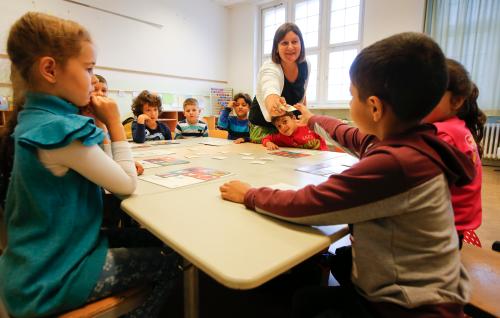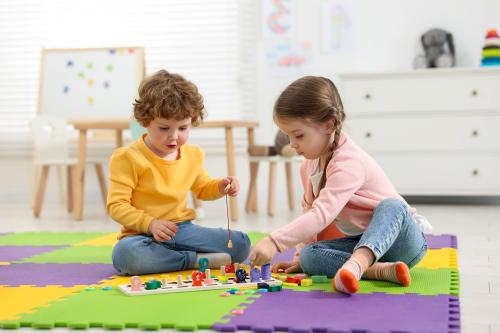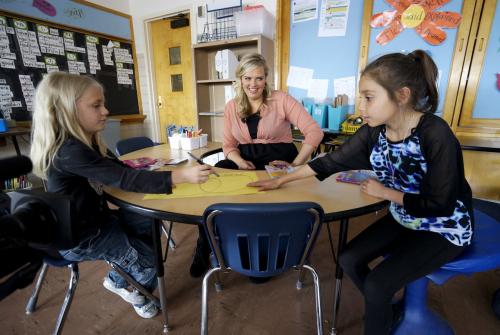This is the second piece in a blog series on learning progressions.
During group time in a preschool classroom, a teacher asks the children to, “Raise a nice quiet hand,” in order to share an idea. What does a child need to know and do in order to comply with this request? Children are being asked to:
- self-monitor behavior;
- think about and plan what to say;
- use audio-representation or visualization to hold onto the response;
- maintain directive attention; and
- interact with and/or question others.
What appears to be a simple task can turn into frustration for child and teacher alike without awareness of these functions and behavioral norms.
It would not be surprising to step into a preschool classroom and observe children learning about numbers, colors, and shapes. It might, however, be surprising to encounter preschool children learning about thinking—their own thinking. That is, preschool children tend to receive instruction and exposure to declarative knowledge (What is a nice quiet hand?), but less so procedural knowledge (How do I plan my response or question before speaking? How do I control myself while raising my hand?). This example is simple, but highlights a larger issue: in early childhood, the focus is often on academic content, but that is not enough. Children need to be able to attend and access instruction as well as apply and elaborate on information gathered from others. The strategies and underlying thought processes that enable children to engage in these behaviors are often known as approaches to learning—a critical foundation for children’s learning and development. Figure 1 illustrates a sample of these strategies, which apply to any grade level.
Figure 1. Three categories of approaches to learning strategies

Source: Chamot, 2009; Bodrova & Leong, 2003
Combining Standards and Developmental Sequences for Preschool
To help teachers isolate and develop learning strategies, AppleTree Institute for Education Innovation (“AppleTree”) developed nine approaches to learning standards (Figure 2) designed to be taught in both explicit and embedded ways.
Figure 2. Approaches to learning standards

These standards were designed to be the backbone of instructional practices and materials, while also providing a roadmap for the progression of typical development and suggested instruction. The standards and their more specific indicators increase in complexity as a teacher moves with a child or class, top-to-bottom and left-to-right (Figure 3). Using this structure, a teacher can identify where a child or group is in their mastery of learning strategies. The teacher may think: Where is this child in their learning? What did he/she already master? What should I target next during direct instruction and purposeful play?
This is not a perfectly linear approach, as children may master skills slightly out of order. However, the general framework operates to show increasing difficulty and skill building in a way that informs instruction, operates as a precursory professional learning tool, and offers a more nuanced approach than a traditional standards list.
Figure 3. Organizing standards and indicators into a progression

Figure 4 shows a sample progression that takes the generic structure in Figure 3 and specifies indicators of increasing complexity for one of the approaches to learning standards “Interactions with Peers”. The indicators can be explicit in small and whole group instruction and built into organic, teachable moments as children interact with each other during child-directed activities. For example, children may complete a silly song or cheer after a peer has a good idea or completes a “tough” task (e.g., finishes a puzzle or jumps really far). A teacher may also use peer partnering so that a child who is adept at writing or making the letter sound for “T” is supporting a child with emerging knowledge of the letter so they may work and learn together to address indicators at the “Approaching” and “Progressing” levels in the progression simultaneously. In this example, approaches to learning standards are embedded within a literacy lesson.
Figure 4. Sample Every Child Ready approaches to learning preschool standard

Applying the Progression to Materials
To bridge the gap between research and practice, professional learning and development of instructional materials are critical to using any progression. Figure 5 shows examples of instructional approaches that can be coupled with a standards-based progression.
Figure 5. Instructional approaches

Note: The term pacing guide can also be referred to as a curriculum map, scope and sequence, or standards schedule. These guides lay out expectations of the material that is to be covered in each subject at each grade level, as well as when they must be taught and how many days to devote to each topic.
Overall, there are a variety of possible complex and rich uses for the information presented above. However, if nothing else, AppleTree hopes that the following message is received by all who participate or implement: Children need to know how to learn not just what to learn.
What’s Next?
Considerable progress has been made in extending what is known about approaches to learning in preschool and applying that in a way that is age-appropriate and engaging for very young learners. Additionally, this extensive work in early childhood can and should be extended meaningfully into later grades, in an effort to better support both teachers and children.
There are multiple goals to this work, including the push to provide preschool as an early prevention measure and the hope of expanding current learning progressions to support the continuum of learning. Although much has been accomplished, there is still more work to be done. Existing literature on learning progressions must be paired with empirical evidence to create a validated and tested framework that educators can use to guide their instruction and scaffold children’s learning.
Tables and graphics created by Adrienne Gaither of AppleTree Institute for Education Innovation.
The Brookings Institution is committed to quality, independence, and impact.
We are supported by a diverse array of funders. In line with our values and policies, each Brookings publication represents the sole views of its author(s).







Commentary
Teaching preschoolers learning strategies: ‘What’ meets ‘how’
April 13, 2018